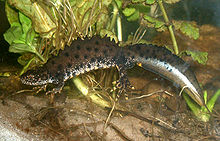
Triturus

Triturus is a genus of newts comprising the crested and the marbled newts, which are found from Great Britain through most of continental Europe to westernmost Siberia, Anatolia, and the Caspian Sea region. Their English names refer to their appearance: marbled newts have a green–black colour pattern, while the males of crested newts, which are dark brown with a yellow or orange underside, develop a conspicuous jagged seam on their back and tail during their breeding phase. Crested and marbled newts live and breed in vegetation-rich ponds or similar aquatic habitats for two to six months and usually spend the rest of the year in shady, protection-rich land habitats close to their breeding sites. Males court females with a ritualised display, ending in the deposition of a spermatophore that is picked up by the female. After fertilisation, a female lays 200–400 eggs, folding them individually into leaves of water plants. Larvae develop over two to four months before metamorphosing into land-dwelling juveniles. Historically, most European newts were included in the genus, but taxonomists have split off the alpine newts (Ichthyosaura), the small-bodied newts (Lissotriton) and the banded newts (Ommatotriton) as separate genera. The closest relatives of Triturus are the European brook newts (Calotriton). Two species of marbled newts and seven species of crested newts are accepted, of which the Anatolian crested newt was only described in 2016. Their ranges are largely contiguous but where they do overlap, hybridisation may take place. Although not immediately threatened, crested and marbled newts suffer from population declines, caused mainly by habitat loss and fragmentation. Both their aquatic breeding sites and the cover-rich, natural landscapes upon which they depend during their terrestrial phase are affected. All species are legally protected in Europe, and some of their habitats have been designated as special reserves. The genus name Triturus was introduced in 1815 by the polymath Constantine Samuel Rafinesque, with the northern crested newt (Triturus cristatus) as type species. That species was originally described as Triton cristatus by Josephus Nicolaus Laurenti in 1768, but Linnaeus had already used the name Triton for a genus of sea snails ten years before, making a new genus name for the newts necessary. Triturus included most European newt species until the end of the 20th century, but was substantially revised after it was shown to be polyphyletic. Three separate genera now accommodate former members of the genus: the small-bodied newts (Lissotriton), the banded newts (Ommatotriton), and the alpine newt (Ichthyosaura). The monophyly of the genus Triturus in the strict sense is supported by molecular data and synapomorphies such as a genetic defect causing 50% embryo mortality (see below, Egg deposition and development). As of 2016, the genus contains nine accepted species. There are seven species of crested newts: Anatolian crested newt (Triturus anatolicus), Balkan crested newt (T. ivanbureschi), Danube crested newt (T. dobrogicus), Italian crested newt (T. carnifex), Macedonian crested newt (T. macedonicus), northern crested newt (T. cristatus), and southern crested newt (T. karelinii). Marbled newts have two species, the marbled newt (T. marmoratus) and the southern marbled newt (T. pygmaeus).
